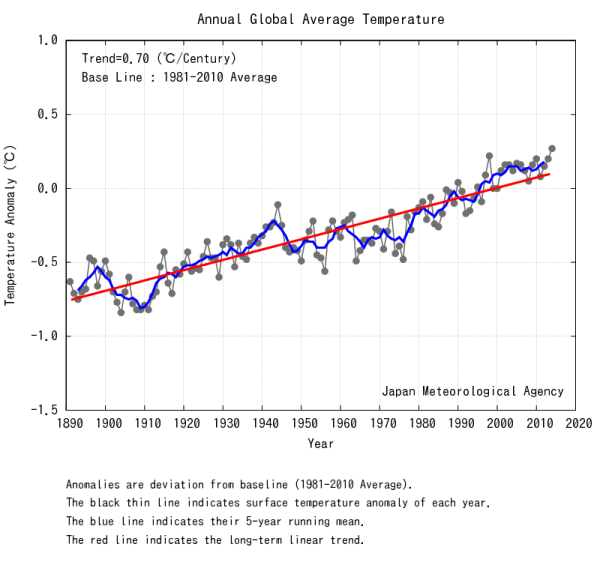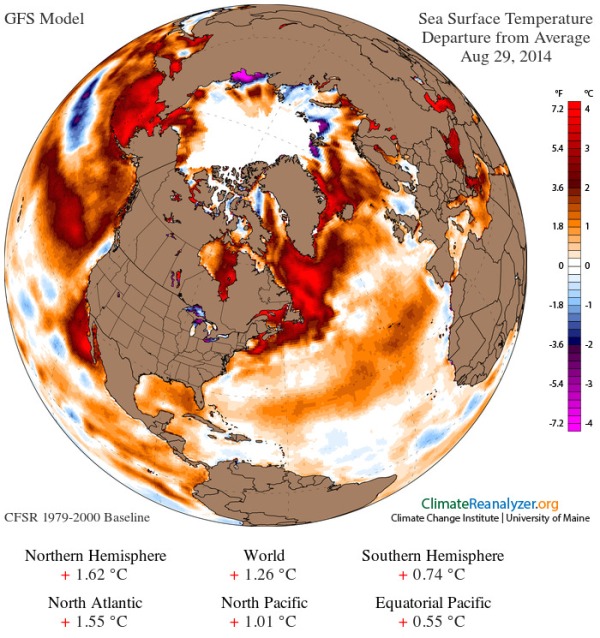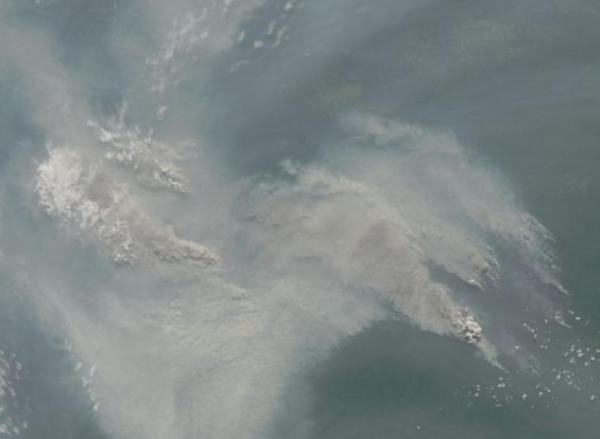Robertscribbler is back
2014
Hottest Year on Record Amidst Ocean Heat Spikes and Arctic Wildfires
6
January, 2015
According
to Japan’s
Meteorological Agency,
2014 set new inauspicious marks as the hottest year in the global
climate record since measures began in 1891.
Temperatures
rocketed to 0.27 C above the 1981-2010 average, 0.63 C above the 20th
Century average and showed a severe pace of warming of 0.70 C per
Century. By comparison, the end of the last ice age featured century
scale warming at the rate of 0.04 to 0.05 C every 100 years. So the
current rate of warming, according to the JMA measure, is 14-17 times
faster. A rapid warm-up driving increasingly severe weather and
geophysical changes.
(JMA measure shows 2014 was hottest year on record. Image source JMA.)
NOAA
is also expected to show 2014 as hottest year on record. NASA is
likely to show 2014 as 1rst, 2nd or 3rd hottest.
2014,
according to JMA, was the first record breaker since the super El
Nino year of 1998 with 2014 beating out 1998 by 0.05 degrees C.
However, the JMA measure also showed that all ten hottest years on
record occurred since 1998. Perhaps more telling is the fact that the
JMA measure reveals no hiatus in the pace of global atmospheric
temperature increase with all years since 1998 at or above the trend
line.
Ocean
Heat but No El Nino
World
ocean surface temperature spikes were the primary driver of the new
global surface temperature record with NOAA’s measure showing a
majority of months as hottest ever recorded for the world ocean.
North Pacific and North Atlantic Ocean temperatures were particularly
hot — with a West Coast heat pool driving ocean dead zone events
and starfish die-offs alike. In this region and off the US East
Coast, Ocean temperature anomalies regularly topped 4 degrees Celisus
above average. An extraordinary degree of heat that, in some cases,
saw tropical fish species heading into Arctic waters for solace from
the record warmth.
(Extraordinary Sea Surface Temperature spikes occurred in late August and mid October, with most of 2014 showing extreme ocean heating. Image source: Climate Reanalyzer.)
El
Nino threatened throughout much of the year. But despite a warming
near the Equatorial Pacific temperature thresholds failed to fully
tip into El Nino. An ominous sign considering that El Nino is the hot
phase of atmospheric and surface temperature variability — which
may mean that the next El Nino will drive a global high temperature
departure even more extreme than 2014’s record setting value.
Severe
Weather, Climate Extremes During Hottest Year
2014
also featured some of the worst weather on record with the US
experiencing extraordinary dipole anomalies coincident with polar
vortex collapse events and severe Arctic warming. Across the
Atlantic, the UK experienced both its stormiest winter on record and
its hottest year on record. A year hotter than any since 1649 for
that nation.
Throughout
the world severe droughts ravaged wide regions with the US Southwest
still in the grips of the worst multi-year drought in 1,200 years.
This year’s California drought was the most recent iteration of
this severe event featuring a ridiculously resilient high pressure
ridge that has continued to rob California of much of its typical
seasonal moisture.
Amazon
drying and wildfires also made news this year amidst a severe drought
gripping the Sao Paulo megalopolis in Southeastern Brazil. The
ongoing drought has shut off monsoonal moisture, forced residents to
ration water, and threatens to put city water officials in the
position of turning to use of mud for municipal water supplies.
Glaciologists
identified massive sections of Antarctic land ice that had reached
the point of irreversible collapse. Many of these researchers pointed
toward an expanding pool of warm bottom water undermining sea facing
glaciers as the culprit for this increasingly rapid glacial melt. A
set of circumstances that creates a higher risk of more rapidly
rising seas.
To
this point, the City of Miami began a combined program of installing
pumps to rid streets of flooding at times of high tide and has
assessed a property tax to begin its efforts to fight the surge of
waters set off by human caused climate change. New studies also found
high risk areas such as Hampton Roads in Virginia now featured tens
of thousands of properties under such serious threat of flooding that
only FEMA will provide them with insurance — a number that will
continue to increase along with the sea levels (globally at 3.3
millimeters of increase per year but as high as 7-8 mm per year in
some regions).
Ominous
Signs the Permafrost is Starting to Disgorge its Carbon Store
Sections
of Siberia and Canada experienced extraordinary warmth during winter
and spring of 2014 — setting off severe early season wildfires that
raged well into late summer. These megafires continue the trend of
recent years in which massive blazes rip through the Siberian tundra
region disgorging methane and CO2 laden smoke plumes that then
encircle the Northern Hemisphere.
For
the Northwest Territories of Canada, this past summer represented its
worst fire year ever recorded with massive blazes forming towering
pyrocumulus clouds over vast burning regions of Arctic permafrost. A
fitting backdrop for the Mordor-like activities of Alberta tar sands
extraction.
(Very intense wildfires, some the size of smalls states as seen above in the LANCE MODIS shot from July of 2014, raged through Siberian tundra this summer. For reference the bottom edge of frame is 120 miles. Image source: LANCE MODIS.)
In
all, about 1,300 gigatons of carbon are stored in the now thawing
permafrost, a region Joe Romm is calling the permamelt (perhaps
permaburn is a better term).
And a human enhanced warming of the Arctic appears to be speeding that carbon’s rate of release into the atmosphere. An impact that could further accelerate human-caused warming. An ignominious circumstance leading to more record warm years and related global climate extremes to come. One that adds urgency to the need to rapidly transition away from fossil fuel burning and human activities that dump massive volumes of carbon into the atmosphere.
And a human enhanced warming of the Arctic appears to be speeding that carbon’s rate of release into the atmosphere. An impact that could further accelerate human-caused warming. An ignominious circumstance leading to more record warm years and related global climate extremes to come. One that adds urgency to the need to rapidly transition away from fossil fuel burning and human activities that dump massive volumes of carbon into the atmosphere.
Links:






No comments:
Post a Comment
Note: only a member of this blog may post a comment.